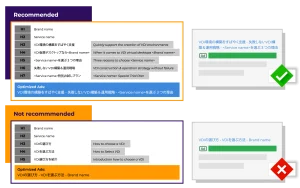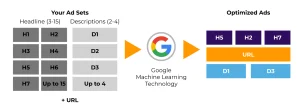September 23, 2024
|5-minute read

Google will limit search text ads services starting on June 30, 2022. However, marketers can use other adaptive advertising to promote a business in Japan.
According to Google, expanded text ads will continue to serve, and marketers can still see performance reports, pause, and resume expanded text ads. Marketers will no longer be able to create or edit text search ads. They can only develop or modify responsive search ads. In short, Google recommends shifting to responsive search ads from expanded text ads.
Marketers understand the significance of Google ads in aiding businesses to stand out in search results and help target the right potential customers. Let us look at how to utilize responsive search ads to target a better market in Japan easily.
Marketers can utilize responsive search ads to create a business accessible to customers by providing preferable Japanese keywords in campaign assets. Consider including preferred Japanese keywords to target specific customers’ locations, regular locations, or points of interest. (learn how to reach potential customers using the right Japanese keywords here).
Remember to write the asset in Japanese nuance and understand market search intent. The intent mismatch will create underperforming ads, resulting in businesses spending more on ads budget but driving fewer leads.
Consider including the highlight of business products and services on the asset—similar or repetitive content reduces the chance to feature appealing business points. Marketers can produce asset variations to determine which combination is conducive to generating leads. A good ad copy is closely related to the business landing page and includes well-known keywords highlighting the company’s unique selling point.

As consumer trends evolve, connecting customers to a business by displaying relevant advertisements benefits for growing business. Responsive search ads combine the marketer’s innovation with an enhanced Google search engine to offer more relevant ads to Japan’s audience.
In particular, Google allows marketers to put a combination of 15 headlines and up to four descriptions in the setup of a single responsive search ad. The headline has a maximum 30 characters limit, and the description has a 90 characters limit.
Japan is well known for three independent writing systems (Hiragana, Katakana, and Kanji), each with its alphabet. When creating assets, complete and half-width kana count as two characters, and half-width alphanumeric count as a character in Japanese writing.

The more assets, the more opportunity to increase performance and match the Japanese search queries.
Google will choose a maximum of three headlines and two descriptions to be shown on the search engine. Additionally, Google recommends the most favorable and relevant ad combinations for different queries, including the asset which generates a better click-through and the highest conversion rate on the assets report. Thus, helping marketers save time and enhance asset performance to more manageable target Japanese customers.
Another feature to utilize from responsive search ads is the pinning assets. Marketers can pin headlines or descriptions to emphasize the keywords and specific messages. Google will show the pinned assets in each responsive ad. However, marketers should understand the effect of pinning, which will prevent other assets from appearing in search queries, thus, reducing the opportunity to match potential customer searches.

Instead of the old text ads service, using responsive search ads is beneficial to achieve effective results. Responsive search ads increase seven percent more conversions at a similar cost per conversion with the same assets as expanded text ads, according to Google Global Internal Data in 2021. However, this result depends on the ad copy and strategy; consequently, providing suitable copywriting is crucial.
Compelling ad copy highlights the critical components of a product or service. There are many challenges marketers encounter in creating ad copy in Japan. Point in fact: in-depth knowledge of the language is a crucial determining factor in the successful ad copy. A/B testing ad copy is also essential for continuously improving the campaign.
Writing the ad copy in English is challenging, but it is even more complex to do in Japanese – a language with many layers and levels. Marketers need to learn about Japanese nuances to grab a suitable choice of keywords. Marketers should know that specific terms only work in Japan; thus, keyword research for ad copy is highly crucial.
Creating relevant Japanese ad copy is fundamental to getting better results from ad campaigns.
Therefore, as a Japanese B2B agency, KKBC aims to help maximize the value of multinational corporate and product brands in Japan by providing suitable keywords to boost copywriting, which spikes the interest of Japanese consumers. Experienced with Japanese nuance, we provide bi-lingual services, which enables us to do what we do best in these specific areas of clients’ needs.
No tags available for this post.
Please enter your email address so we can send you a one-time pass code and verify if you are an existing subscriber.